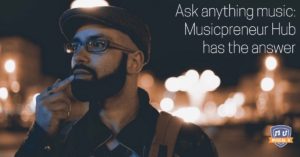Opportunity: noun, a set of circumstances that makes it possible to do something.
Where do you find that oftentimes-elusive “set of circumstances”? Do you ever have the odd feeling that it’s everywhere – if only you could open your eyes a little wider?
Composer Kangyi Zhang has learned valuable lessons about staying open to opportunity. Hint: don’t so set in what you think the circumstances are supposed to be that you miss the unexpected meetings and interactions available to you all the time.
Many artists are finding opportunities to radically expand their audience by re-imagining cover songs. And we can open opportunities to expand our musicality with a simple attitude shift. For example, just because something sounds like a brain-bending theory bomb – like modal improvisation – doesn’t mean that it is really all that difficult to grasp.
The internet opens up the world of opportunities (and everything else!) to our hungry eyes. The music business’ secret handshake deals behind closed doors are now revealed! This week Tommy Darker launched Musicpreneur Hub, where everyone has the opportunity to ask any question at all about music and the music business, and receive quality answers from vetted active music industry players.
Real. Good. Answers
 When we apply that same creative energy we access when creating music to our entrepreneurship skills in promoting our music, we become “musicpreneurs”. But how do we know when we’re directing that energy efficiently to move forward or throwing confetti to the wind?
When we apply that same creative energy we access when creating music to our entrepreneurship skills in promoting our music, we become “musicpreneurs”. But how do we know when we’re directing that energy efficiently to move forward or throwing confetti to the wind?
Whether it’s how to learn a certain scale, how to mix your next release, or how to thrive in the music business, Tommy Darker wants to make the music world transparent and available to all who have the drive and desire to succeed with their musical lives.
Seeing that – despite the internet – so much of the inner workings of music and music business remain hidden, he launched Musicpreneur Hub. Now you can ask anything music: Musicpreneur Hub has the answer.
And this Saturday (20th May 2017) we’re offering a free online masterclass with Tommy. He’ll be talking about networking for musicians – how to find and connect with the right people to move your music forwards. To register for this awesome opportunity, click here.
One of the many benefits to Musicpreneur Hub is the ability to network with other musicians. Why is this important? Schwilly Family Musicians discusses the necessity of networking in today’s interconnected world.
Of the many items of interest in Musicpreneur Hub is professional guidance to help you manage tasks such as collecting royalties for your music. Modern Songstress gives us a glimpse into how complicated the royalties process can become.
As you are aware, the music industry is an incredibly complex machine, and Musicpreneur Hub is built to help musicians navigate their way through. Skyelab Music lays out the truths in today’s music industry that may help you get more traction with listeners.
Finding Yourself in “Find You”
 Covering your favorite songs gives you the opportunity to express your creativity and grow your audience without the burden of having to write the next big hit. Twenty One Two’s soaring pop-punk tribute to Zedd’s “Find You” trades synths and FX for drums and strums with dynamic rock vocals.
Covering your favorite songs gives you the opportunity to express your creativity and grow your audience without the burden of having to write the next big hit. Twenty One Two’s soaring pop-punk tribute to Zedd’s “Find You” trades synths and FX for drums and strums with dynamic rock vocals.
Learning how others cover songs opens our ears to creating our own cover opportunities. See how Twenty One Two does it in Before and After: Covering Zedd.
Performing cover songs is a staple of many beginning musical groups. However, if you’re doing a straight version of the song, the audience will have certain expectations as to what the song should sound like. Nashville Three Sixty provides unique insights in how to choose a proper cover song to add to your setlist.
YouTube has become one of the most popular social media sites to post cover songs (Facebook is prone to deleting them!). Soundfly gives helpful tips on creating great cover songs to expand your abilities as a musician and learn more about songwriting:
Great! You have found a song that you would like to cover. Now, how do you go about actually recording your own version of the song? Talitha explains her process for creating great cover songs.
Recently Talitha posted a new video going into much more detail on her equipment and how she uses Reaper, a DAW for recording.
Behind the Modal Madness
 Some people like to make things so complicated! And sometimes we actually fall for it, holding ourselves back from a new opportunity because it seems too “hard”.
Some people like to make things so complicated! And sometimes we actually fall for it, holding ourselves back from a new opportunity because it seems too “hard”.
Modal improvisation, practiced by absolute monsters like John Coltrane and Steve Vai, can actually be a very easy, enjoyable, and pleasant way to open our ears to new melodic possibilities – and, eventually, help us to better understand how notes and harmonies fit together.
In Crazy Easy Weird (Modal) Improv Trick we learned a simple improv experiment to experience the modes.
This week, in Crazy Easy Weird (Modal) Improv Trick, Part 2, we take an equally simple, but more systematic approach to understanding how the modes work, what to do with them, and what those Greek names are all about.
Modes in Western music were first described at least 1000 years ago. While playing with modes can be quite simple and intuitive, theorists of the Renaissance in the 16th and 17th centuries attempted to explain them with what seems to our minds as a rather complicated system. This fascinating video from Early Music Sources talks about the origin of modes and how they came to be understood during this period.
Learning all of the modes can seem like a daunting task! How many scales is one supposed to remember anyway?! Ledger Note makes it easy with their explanation of musical modes.
While modes are often talked about when referring to the melody, they can be quite useful in constructing the bass line as well. This great Q & A from No Treble talks about using modes for bass and the relationship between the modes.
The Path Unknown
When Kangyi Zhang began his musical studies on the traditional Chinese dizi flute, he had no idea that his path would lead to a dynamic career as a contemporary Western classical composer melding traditional and modernist techniques with the infinite possibilities of contemporary electronics.
That’s because Kangyi has mastered the life skill of always being on the lookout for opportunities – without prejudice as to where and when that “set of circumstances” may present itself. In other words, he’s come to expect the unexpected and been willing to take the path unknown. Inspire yourself to do the same when you read about A Composer’s Path, Part 3: Opportunity, with Kangyi Zhang.
Kangyi talked about the importance of finding opportunities as a musician and a composer. Synch Blog shows us all the opportunities that social media provides to implement “old school” ideas on reaching the audience’s ears.
 Promoting yourself as a composer can be a difficult proposition, even with the number of communication channels that we currently have available to us. New Artist Model has some helpful suggestions on how not to waste time on social media gaining exposure and getting new listeners.
Promoting yourself as a composer can be a difficult proposition, even with the number of communication channels that we currently have available to us. New Artist Model has some helpful suggestions on how not to waste time on social media gaining exposure and getting new listeners.
Making music can be a difficult profession that requires dedication and persistence. If you are losing motivation, Symphonic Distribution will be sure to inspire you to dig deeper and find the “why” in your music career.
The Doors are Open
The infinite possibilities offered by today’s global connectedness can be overwhelming. Sometimes it’s a Kangyi Zhang-style tightrope walk between knowing what you want, and being open to opportunities you didn’t even know existed. And sometimes, like Tommy Darker, you want to cut through all the noise and find clear reliable answers.
When we don’t sell ourselves short, we learn that new musical techniques, like modal improvisation, aren’t nearly as hard as we thought, and that we may have something new to say with an old song.
Looking for opportunity? Start with this week’s posts on Musical U and expand your vision!







